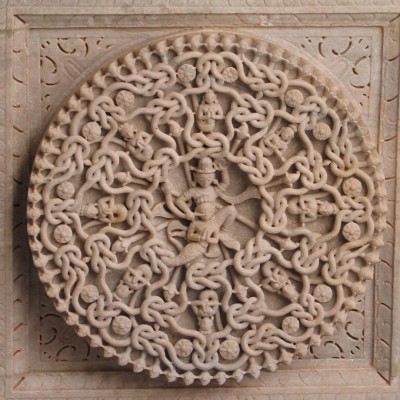The Jain Subtle Body
Back To Blogs

The Jain tradition teaches that the soul (jīva) is an eternal, sentient entity bound by karma in a cycle of death and rebirth. Central to this process is the subtle body (sūkṣma śarīra), which stores the karma that causes us to be reborn again and again. This subtle body is not only central for karma accumulation, transmigration, and spiritual evolution, but also consists of layers that enable various powers.
Layers of the Self in Jainism
Jain philosophy as found in the Tattvārthasūtra (see Tatia 2011) describes five interconnected and increasingly subtle bodies by which each of us is composed, with each serving a unique function. The first is made of physical matter, while the remaining four are made of more subtle matter. The last four (2-5) comprise the subtle body:
When the subtle body is completely purified, the soul attains kevala-jñāna (omniscience) first, leading eventually to mokṣa at the time of one’s death.
Conclusion
The subtle body (sūkṣma śarīra) plays a crucial role in karma, rebirth, and spiritual evolution in the Jain tradition. Understanding the karmāṇa śarīra helps Jains think about the impact of their actions and the importance of self-purification. By adopting the Jain practices of non-violence, self-discipline, yoga, and meditation, one can cleanse the subtle body and move toward liberation in a future lifetime.
Ultimately, Jainism teaches that our present actions shape our future lives. Through conscious living and spiritual discipline, only we hold the power to transform our destiny.
Interested in learning more about Jain Philosophy? Why not enroll in our MA – Engaged Jain Studies program?
References
Tatia, Nathmal. 2011. That Which Is: Tattvārtha-Sūtra. San Francisco: Harper Collins.

Karma, Ceiling Sculpture (Shapes and Knots connected to each other to depict the connection between Karma and Life). Jain Temple ceiling ornament, Ranakpur, Rajasthan, India. Shakti, 2008.
The Jain Subtle Body
A Deeper Look into the Sūkṣma Śarīra
05/08/2025
You may have heard about the subtle body in yoga traditions, for example, but do you know about the subtle body of the Jain tradition?
The Jain tradition teaches that the soul (jīva) is an eternal, sentient entity bound by karma in a cycle of death and rebirth. Central to this process is the subtle body (sūkṣma śarīra), which stores the karma that causes us to be reborn again and again. This subtle body is not only central for karma accumulation, transmigration, and spiritual evolution, but also consists of layers that enable various powers.
Layers of the Self in Jainism
Jain philosophy as found in the Tattvārthasūtra (see Tatia 2011) describes five interconnected and increasingly subtle bodies by which each of us is composed, with each serving a unique function. The first is made of physical matter, while the remaining four are made of more subtle matter. The last four (2-5) comprise the subtle body:
- Gross Body (Audārika Śarīra) – the physical body that undergoes birth, aging, and death. Embodied humans, animals, and plants experience pleasure and pain through the mind and senses.
- Protean Body (Vaikriyā Śarīra) – enables extraordinary transformations, such as for gods, hell-beings, some animals, and ascetics to be able to shape-shift. Gods and hell-beings experience pleasure and pain through the protean body. Humans and animals gain access to it through austerities.
- Conveyance Body (Āhāraka Śarīra) – is auspicious (śubha) and made of subtle matter that smells, feels, and tastes pleasant. It is furthermore pure (viśuddhi), and thereby transparent, shiny, and conducive to harmless conduct. Finally, it is made of unobstructed clusters (avyāghāti) which move unimpeded through space. The conveyance body is used to get knowledge of subtle issues from the omniscient Jinas within a period of 48 minutes. Critically, only an ascetic learned in 14 books of early literature (caturdaśa-pūrvadhara) can create the conveyance body. Since these lost texts are not available in our current time cycle, it is seemingly not possible to access the conveyance body at this time.
- Fiery Body (Taijasa Śarīra) – is a permanent aspect of the worldly soul. It digests food to nourish the gross body. Through austerities, the fiery body can be used to shoot hot or cold rays at objects at a distance! It cannot bind, suppress, or eliminate karma – the first 3 bodies do this; the fiery body merely provides energy for the other bodies.
- Karmic Body (Kārmaṇa Śarīra) – is made by its own cause and causes all other bodies (like the sun that illuminates itself and all other objects, for example). It is made from clusters of matter and is a subtype of body-making karma. The Karmic Body is indeed the basket that holds all of the karma particles trapping the soul.
Role of the Subtle Body in Karma and Rebirth
Jainism views karma as a real, subtle material substance that clings to the soul due to passions (kaṣāyas) like anger, pride, deceit, and greed. The karmāṇa śarīra functions as a repository of these karmic particles, determining the nature of future rebirths.
At death, the subtle body immediately guides the soul to its next incarnation based on accumulated karma. It shapes physical form, lifespan, intelligence, and future experiences, for example, ensuring that the cycle of death and rebirth (saṃsāra) continues until one has been able to burn away all of their karma and achieve final liberation (mokṣa).
At death, the subtle body immediately guides the soul to its next incarnation based on accumulated karma. It shapes physical form, lifespan, intelligence, and future experiences, for example, ensuring that the cycle of death and rebirth (saṃsāra) continues until one has been able to burn away all of their karma and achieve final liberation (mokṣa).
How to Purify the Subtle Body
Since the kārmaṇa śarīra binds the soul to saṃsāra, Jainism emphasizes spiritual discipline for karmic purification through:
Since the kārmaṇa śarīra binds the soul to saṃsāra, Jainism emphasizes spiritual discipline for karmic purification through:
- Right Knowledge (Samyag Jñāna)
- Right Faith (Samyag Darśana)
- Right Conduct (Samyag Cāritra) – Practicing virtues like ahiṃsā (non-violence), satya (truthfulness), and aparigraha (non-possessiveness).
When the subtle body is completely purified, the soul attains kevala-jñāna (omniscience) first, leading eventually to mokṣa at the time of one’s death.
Conclusion
The subtle body (sūkṣma śarīra) plays a crucial role in karma, rebirth, and spiritual evolution in the Jain tradition. Understanding the karmāṇa śarīra helps Jains think about the impact of their actions and the importance of self-purification. By adopting the Jain practices of non-violence, self-discipline, yoga, and meditation, one can cleanse the subtle body and move toward liberation in a future lifetime.
Ultimately, Jainism teaches that our present actions shape our future lives. Through conscious living and spiritual discipline, only we hold the power to transform our destiny.
Interested in learning more about Jain Philosophy? Why not enroll in our MA – Engaged Jain Studies program?
References
Tatia, Nathmal. 2011. That Which Is: Tattvārtha-Sūtra. San Francisco: Harper Collins.
Christopher Jain Miller, is the co-founder, Vice President of Academic Affairs, and Professor of Jain and Yoga Studies at Arihanta Institute. He completed his PhD in the study of Religion at the University of California, Davis and is also a Visiting Researcher at the University of Zürich's Asien-Orient-Institut and Adjunct Professor at Claremont School of Theology where he co-developed and co-runs a remotely available Masters Degree Program focusing on MA-Engaged Jain Studies graduate program.
